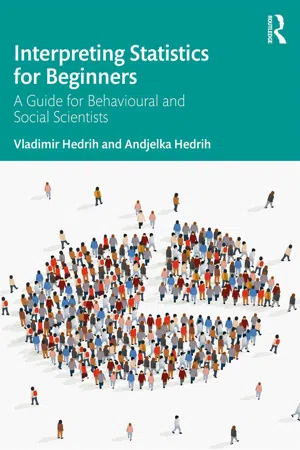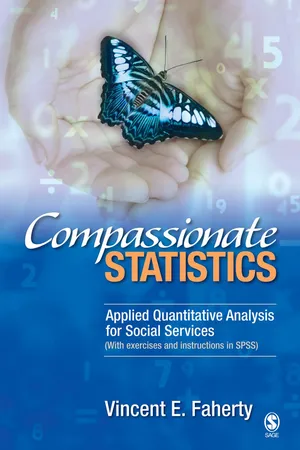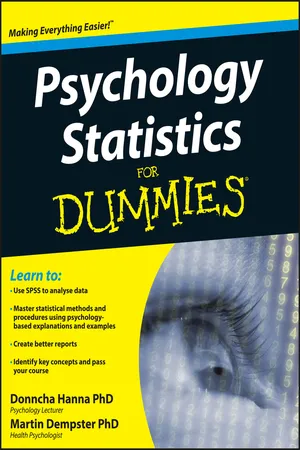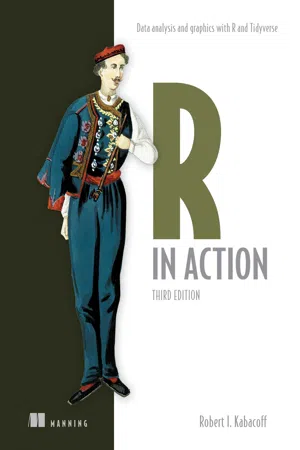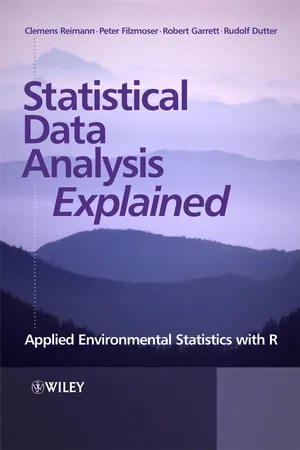Psychology
Scatter Plots
Scatter plots are visual representations of the relationship between two variables. In psychology, they are often used to examine the correlation between different psychological traits or behaviors. Each data point on the plot represents an individual, allowing researchers to identify patterns and trends in the data.
Written by Perlego with AI-assistance
Related key terms
9 Key excerpts on "Scatter Plots"
- eBook - ePub
Interpreting Statistics for Beginners
A Guide for Behavioural and Social Scientists
- Vladimir Hedrih, Andjelka Hedrih(Authors)
- 2022(Publication Date)
- Routledge(Publisher)
. A scattergram is a graphical presentation of the relationship between two variables. It is typically a two-dimensional graph where each of the two variables is represented by one dimension. The entities are represented by points whose coordinates on the graph are values on the two variables. In that way, a graph containing a set of dots is produced and from the way dots are grouped we can make inferences about the likely type of relationship between the two variables, the direction of their correlation and also of the approximate intensity of the relationship (Figures 6.3 and 6.4 )..Figure 6.3Examples of scattergrams depicting correlations between two variables of various intensity and directions. We can see that as the correlation between variables becomes stronger, so does the general shape of the dots on the scattergram become flatter and, in the opposite direction, as the correlation becomes weaker, so does the shape of the configuration of dots on the scattergram become rounder. The upper 4 scattergrams depict positive correlations, while the bottom two depict negative correlations. We can see that, when the correlations are negative, high values of one variable, correspond to low levels of the other variable. The data comes from various studies conducted by the authorsHackinger et al. (2016) , with the permission of authors and it is made available under the Creative Commons Attribution 4.0 International License (http://creativecommons.org/licenses/by/4.0/Figure 6.4An example of a scattergram depicting a slightly nonlinear, monotonic, positive correlation. The image is reprinted from - Thomas Gus Almonroeder(Author)
- 2022(Publication Date)
- Routledge(Publisher)
As you progress through this chapter, you’ll learn more about how to both qualitatively and quantitatively examine the relationship between variables, as well as other key information that can be gleaned from a scatter plot. However, as a primer, let’s start by simply describing some general things that can be observed from the scatter plot in Figure 8.1. First, you’ll notice that there appears to be a general pattern to the data points, as they tend to start in the bottom-left corner and move toward the top-right corner of the scatter plot. This indicates that athletes with stronger lower bodies (i.e. greater one repetition maximum weights) tended to be able to jump higher. You’ll also notice that most data points appear to be located fairly closely to the line of best fit but that very few data points lie directly on the line. Finally, you’ll see that some of the data points are located farther from the line of best fit than others. For example, the athlete whose data point is circled didn’t appear to fit the general pattern observed for the sample, as his lower body strength was slightly below average, but he was able to jump higher than almost all of the other athletes in the study.As you can already see, Scatter Plots provide a tremendous amount of information. Examining a scatter plot is often done as a preliminary step to qualitatively visualize the nature of the relationship (or lack thereof) between variables before performing a more quantitative analysis. Scatter Plots can also help us determine whether our data meets some of the key assumptions associated with bivariate correlation (discussed at the end of this chapter). Fortunately, Scatter Plots are fairly easy to generate and are often standard output when conducting a bivariate correlation analysis using most statistical analysis software packages. Scatter Plots are also commonly included as figures in research articles that report the results of a bivariate correlation analysis.An introduction to correlation coefficients
While examining a scatter plot allows us to qualitatively assess the relationship between two variables, correlation coefficients help to quantitatively characterize the nature of the relationship. The Pearson product-moment correlation coefficient, which is typically represented by a lowercase, italicized r and often referred to as the ‘r value’, is commonly used to quantitatively describe the relationship between two continuous variables. Throughout this chapter, any reference to a correlation coefficient, or r- eBook - ePub
Compassionate Statistics
Applied Quantitative Analysis for Social Services (With exercises and instructions in SPSS)
- Vincent Faherty(Author)
- 2007(Publication Date)
- SAGE Publications, Inc(Publisher)
Chapter 11 , will introduce correlations used for inferential purposes.Scattergrams/Scatterplots
It would be perfectly legitimate to portray the existence of a numerical correlation between two variables in a standard table, as in Table 10.1 .Unfortunately, the true nature of this correlation is not easily apparent in a table format. Only partially revealed in Table 10.1 is the fact that the data indicate (surprisingly) that the longer clients stayed in treatment at this agency, the worse became their attitude about that agency’s effectiveness. It is for this reason that most researchers create scattergrams, rather than tables, to present correlations used solely for descriptive purposes.Table 10.1 Table of the Length of Client Contact (in Weeks) and Client Attitude Toward Agency Effectiveness (10 = Very High , 1 = Very Low )Client # Contact in Weeks Attitude Toward Agency 01 2 10 02 4 8 03 7 2 04 6 3 05 4 6 06 2 10 07 7 2 08 10 1 09 5 5 10 7 3 11 3 8 12 2 8 13 8 3 14 9 1 15 4 10 16 8 2 17 4 10 A scattergram , also called a scatterplot, offers a clear visual image of the intersection of the values contained in the two variables. Scattergrams are conceptually based on the image of the X axis and Y axis. You are undoubtedly familiar with this image since it is commonly used as a template in economics and business administration classes to display economic trends and forecasts.A scattergram literally pinpoints where individual cases (usually people) are placed on a grid bounded by the possible values of the two variables being analyzed, then scatters those points, thereby forming some variation of a pattern. These possible values start at an absolute zero point, where the X axis crosses the Y axis, and then continue to increase vertically and horizontally out from that zero point, as illustrated in Figure 10.4 - eBook - ePub
- Donncha Hanna, Martin Dempster(Authors)
- 2012(Publication Date)
- For Dummies(Publisher)
y -axis (it doesn’t matter which way round they are). The number of data points you have is equal to the number of cases or participants you have (if they each have unique scores) or less than your sample size (if some participants have exactly the same scores on both variables).Scatterplots are most useful if the variables have a reasonably wide range of scores and you have a large sample size, otherwise you may find seeing relationships hard.Figure 12-1: A scatterplot demon-strating a perfect linear relationship.Inspecting a scatterplotVisually inspecting any scatterplot can inform you about the relationship between two variables. These relationships can take many shapes, but the only one you’re interested in for now is the straight line, or linear relationship . If you look at Figure 12-1 you see a clear linear relationship running from the bottom left corner to the top right corner of the plot, or uphill; as one variable increases in magnitude, the second variable also increases in magnitude. This is known as a positive relationship and it represents a very strong relationship because the linear relationship is very clear.Now look at Figure 12-2. You see a positive linear relationship, but it’s not perfect as in Figure 12-1. An increase in one variable tends to be related to an increase in the second variable. For example, students who have high marks in their first year tend to have higher marks in the final year, but this relationship isn’t perfect. This is more like the relationships you observe when conducting your analysis: it is very unlikely you will ever find two variables that have a perfect relationship.You can also have a negative relationship between two variables where an increase in one variable is related to a decrease in the second variable. For example, Figure 12-3 illustrates the relationship between participants’ health scores and number of sick days. The data points run from the top left corner of the plot towards the bottom right corner, or downhill, representing a strong negative relationship. Higher health scores relate to lower numbers of sick days. - eBook - ePub
R in Action, Third Edition
Data analysis and graphics with R and Tidyverse
- Robert I. Kabacoff(Author)
- 2022(Publication Date)
- Manning(Publisher)
Scatter Plots and scatter plot matrices allow you to visualize relationships between quantitative variables two at a time. The plots can be enhanced with linear and loess fit lines showing trends.- When you’re creating a scatter plot based on a large volume of data, methods that plot densities rather than points are particularly useful.
- The relationships among three quantitative variables can be explored using 3D Scatter Plots or 2D bubble charts.
- Change over time can be described effectively with line charts.
- Large correlation matrices are difficult to understand in table form, but easily explored via corrgrams—visual plots of correlation matrices.
- The relationships between two or more categorical variables can be visualized with mosaic charts.
- Kimmo Vehkalahti, Brian S. Everitt(Authors)
- 2018(Publication Date)
- CRC Press(Publisher)
in Figure 2.16. The plot for the children’s observations shows a marked departure from linearity but the plot for the adults’ data looks linear. These findings might need to be considered before any formal test or procedure is applied to the data set, although here constructing the usual normality based confidence interval is unlikely to be misleading. Figure 2.16 Probability plots of counts of “and then …” statements by children and adults. Probability plots have been around for a long time, but they remain a useful technique for assessing distributional assumptions in some cases as here for the raw data, but also for the residuals that are used to assess the assumptions when fitting models to data, as we shall see in Chapter 3. 2.3 The Scatterplot and beyond The simple xy scatterplot has been in use since at least the 18th century and has many advantages for an initial exploration of data. Indeed, according to Tufte (1983): The relational graphic—in its barest form the scatterplot and its variants—is the greatest of all graphical designs. It links at least two variables encouraging and even imploring the viewer to assess the possible causal relationship between the plotted variables. It confronts causal theories that x causes y with empirical evidence as to the actual relationship between x and y. Let us begin by looking at a straightforward use of the scatterplot using some of the data in Table 2.4. These data were collected from a sample of 24 primary school children in Sydney, Australia. Part of the data is given in Table 2.4. Each child completed the Embedded Figures Test (EFT), which measures “field dependence,” that is, the extent to which a person can abstract the logical structure of a problem from its context. Then the children were allocated to one of two experimental groups, and they were timed as they constructed a 3 × 3 pattern from nine colored blocks, taken from the Wechsler Intelligence Scale for Children (WISC)- eBook - ePub
- Bruce J. Chalmer(Author)
- 2020(Publication Date)
- CRC Press(Publisher)
11Describing Relationships Between Two Variables
11.1 A scatterplot shows the shape of a relationship between two variables.
Relationships between variables
Before we discuss ways of describing relationships between variables, we need to consider why we should bother. The answer is the same as it was when we considered group differences on a single variable: Many scientific hypotheses can be stated in terms of the relationship between two variables. In fact, the issue of group differences can itself be considered in terms of a relationship between two variables and some of the same techniques apply, as we will see.What do we mean by a “relationship” between variables? To say that two variables are related means that knowledge of an individual's score on one variable changes our best guess about the individual's score on the other variable.For example, yield of com per hectare and amount of rainfall during the growing season are presumably related to each other. If we knew nothing else about a given farm (besides the fact that com was planted there), our best guess about the yield we might expect from that farm would simply be the average com yield. But if we were given information about the rainfall at the farm, our guess would probably be affected. If we were told that there is almost no rain at the farm, then, in the absence of irrigation, we would expect a very low yield. If we were told that there is too much rain, we would similarly expect a low yield. If we were told that the amount of rain is just right for com, we would expect a high yield.Figure 11.1 shows a graphical representation of this type of relationship. By drawing such a picture, we can characterize the “shape” of a relationship. In this case it is curvilinear: High com yields are associated with moderate rainfall, with lower yields for very high or very low rainfall.Scatterplots
Of course, Figure 11.1 is unrealistic. Even though rainfall undoubtedly does affect com yield, it is not the only factor. Many other things matter also. Knowing the amount of rainfall would change our best guess about com yield, but we still would not be able to predict com yield perfectly - eBook - ePub
Statistics for Psychologists
An Intermediate Course
- Brian S. Everitt(Author)
- 2001(Publication Date)
- Psychology Press(Publisher)
does emerge, and a dependence of failure on temperature is revealed.To end the chapter on a less sombre note, and to show that misperception and miscommunication are certainly not confined to statistical graphics, see Figure 2.35 .2.10. SummaryFig. 2.35. Misperception and miscommunication are sometimes a way of life. (© The New Yorker collection 1961 Charles E. Martin from cartoonbank.com. All Rights Reserved.)- Graphical displays are an essential feature in the analysis of empirical data.
- In some case a graphical “analysis” may be all that is required (or merited).
- Stem-and-leaf plots are usually more informative than histograms for displaying frequency distributions.
- Box plots display much more information about data sets and are very useful for comparing groups. In addition, they are useful for identifying possible outliers.
- Scatterplots are the fundamental tool for examining relationships between variables. They can be enhanced in a variety of ways to provide extra information.
- Scatterplot matrices are a useful first step in examining data with more than two variables.
- Beware graphical deception!
Pie charts, bar charts, and the like are easily constructed from the Graph menu. You enter the data you want to use in the chart, select the type of chart you want from the Graph menu, define how the chart should appear, and then click OK. For example, the first steps in producing a simple bar chart would be as follows.- Enter the data you want to use to create the chart.
- Click Graph, then click Bar. When you do this you will see the Bar Charts
- eBook - ePub
Statistical Data Analysis Explained
Applied Environmental Statistics with R
- Clemens Reimann, Peter Filzmoser, Robert Garrett, Rudolf Dutter(Authors)
- 2011(Publication Date)
- Wiley(Publisher)
This plot is typically displayed as an elongated rectangle. Each value is plotted at its correct position along the x -axis and at a position selected by chance (according to a random uniform distribution) along the y -axis (Figure 3.2, lower diagram). This simple graphic can provide important insight into structure in the data. Figure 3.2 Evolution of the one-dimensional scatterplot demonstrated using Sc as measured by instrumental neutron activation analysis (INAA) in the samples of the Kola C-horizon In Figure 3.2 (stacked and one-dimensional scatterplot) a significant feature is apparent that would be important to consider if this variable were to be used in a more formal statistical analysis. The data were reported in 0.1 mg/kg steps up to a value of 10 mg/kg and then rounded to full 1 mg/kg steps – this causes an artifical “discretisation” of all data above 10 mg/kg. 3.2 The histogram One of the most frequently used diagrams to depict a data distribution is the histogram. It is constructed in the form of side-by-side bars. Within a bar each data value is represented by an equal amount of area. The histogram permits the detection at one glance as to whether a distribution is symmetric (i.e. the same shape on either side of a line drawn through the centre of the histogram) or whether it is skewed (stretched out on one side – right or left skewed). It is also readily apparent whether the data show just one maximum (unimodal) or several humps (multimodal distribution). The parts far away from the main body of data on either side of the histograms are usually called the tails. The length of the tails can be judged. The existence or non-existence of straggling data (points that appear detached from the main body of data) at one or both extremes of the distribution is also visible at one glance
Index pages curate the most relevant extracts from our library of academic textbooks. They’ve been created using an in-house natural language model (NLM), each adding context and meaning to key research topics.
